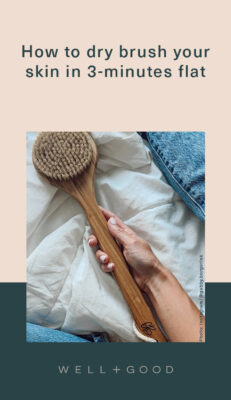A Lazy-Girl’s Guide to Dry Brushing Your Winter Skin in 3-Minutes Flat
“Dry brushing has been used in many cultures for centuries to help remove dead skin cells and increase circulation,” says Kimberly Kelder, lead esthetician at Miraval Arizona Resort & Spa.
Firstly, dry brushing helps promote lymphatic flow and drainage, which allows the body to detoxify itself naturally (read: no green juices or colon cleanses necessary). Increasing circulation through dry brushing also helps reduce the appearance of cellulite, Kelder adds. (And it might work at the cellular level, too: research from the International Journal of Cosmetic Science found that the pressure of a massage—in this case administered by a dry brush—can help reduce tissue edema under the skin that presents as cellulite, as well as help stimulate fibroblast and keratinocyte activity while decreasing adipocyte activity).
On a surface level, dry brushing works to reveal glowing skin by loosening and removing dead skin cells that carry dirt, oil, and residue, Kelder explains. What’s more is that sloughing off dead skin helps enhance the efficacy of your moisturizer since it won’t longer need to traverse an icky barrier to work its magic. And according to the Cleveland Clinic, dry brushing also stimulates the nervous system, which can help you feel mentally invigorated. Is there anything dry brushing can’t do?
While it’s certainly not a cure-all, it’s a helpful way to look and feel your best in three minutes.

Your step-by-step guide for how to dry brush
Here, Kelder shares a fail- and fool-proof method for getting in on this ultimate skincare routine. Note that while dry brushing is appropriate for all skin types, those with sensitive skin should avoid applying lots of pressure, and those with open wounds should avoid the practice altogether.
- Pick a dry brush specifically designed for use on the body. Kelder says to look for medium to soft bristles (that also have a firmness to them) made of natural materials like cactus or agave bristles called sisal.
- Stand in the shower before you turn on the water.
- In light strokes, massage your body in an upwards motion, starting with your feet, and move up to your calves, thighs, hips, and beyond.
- Hold the long arm of the brush to access harder-to-reach back areas.
- Shower like you normally would to slough off dead skin cells.
- Rinse your dry brush to prevent dead skin accumulation.
- Towel off and apply body moisturizer, oil or cream.
- Repeat daily for optimal results.
How to select your moisturizer
What you do after your dry brushing session is equally as important as the brushing itself. “I recommend using a body lotion for what your concern is,” says Kelder.

{{post.sponsorText}}
For dry skin, she recommends using a cream complete with shea butter or ceramides, which are lipids that help form a protective barrier over your skin, or a body lotion with hyaluronic acid, a potent molecule that retains moisture. If aging is your concern, look for a body cream with alpha hydroxy acid, which helps unclog pores, or retinol, which helps stimulate cell regeneration. If you’re looking to prevent and/or heal sun damage, opt for a body cream with SPF or the antioxidant vitamin C, respectively.
Not sure where to start? Kelder’s ultra-hydrating favorites include Naturopathica Sicilian Bergamot Body Lotion, EmerginC Vitamin C, Hemp, Avocado and Argan Body Lotion, Laurel Sun Body Oil, and Coola’s Mineral Body Sunscreen Lotion SPF 30.
Suffice to say, I will be retiring my old hair brush in favor of something that actually does the trick—and is far less disgusting.
And here's the right way to wash your face:
Looking for more ways to keep your skin feeling super soft through the harsh winter months? DIY a sugar scrub for some easy exfoliation (it's only three ingredients!) or check out this cold cream for baby-soft skin.
Loading More Posts...